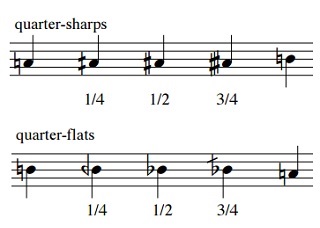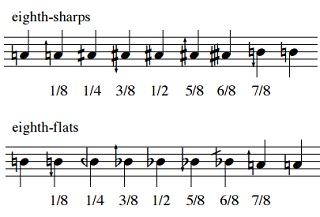Western scales vs Eastern maqamat
Arabic, Turkish, and Western music theory are all based on Pythagorean tuning, but have evolved differently over the centuries.
- Western: a series equally tempered whole-tones and half-tones.
- Arabic: a series of whole-tones and half-tones with pitches augmented or diminished by one quarter-tone (2 Pythagorean commas).
- Turkish: a series of whole-tones and half-tones with pitches augmented or diminished by one-eighth of a whole-tone (1 Pythagorean comma) or by one quarter-tone (2 Pythagorean commas).
Microtonal melodies are out of tune to the Western ear exposed only to equal temperament. But to the trained ear, they are a gateway to a variety of colors and sensations.
"The most remarkable peculiarity in the Arab system of music is the division of tones into thirds. Hence I have heard Egyptian musicians urge against the European systems of music that they are deficient in the number of sounds. These small and delicate gradations of sound give a peculiar softness to the performances of the Arab musicians, which are generally of a plaintive character: but they are difficult to discriminate with exactness, and are therefore seldom observed in the vocal and instrumental music of those persons who have not made a regular study of the art... The natives of Egypt are generally enraptured with the performances of their vocal and instrumental musicians: they applaud with frequent exclamations of Allah! and God approve thee! and God preserve the voice! and similar expressions."— Edward Lane
"Yet one point may be earnestly impressed upon the reader and musician at the outset. There is no definate scale that can be traced to any immutable physical law... We are so prone to imagine that our scale (major and minor) is the sum of all music... The Hindoo scale divides into third-tones and quarter-tones in a manner that defies notation by our system or performance upon our keyed instruments."— Louis Elson
"The fundamental points of divergence between Eastern and Western music are the employment of quarter tones, the displacement of F and B (which are respectively a quarter tone above and below the Western notes), the entire neglect of harmony and counterpoint, and the use of most complicated rhythms... Arab music differs in some particulars from the Western scale. Arab notes fall exactly on G, A, C, D and F: but the notes Iraq and Sigah fall a quarter-tone below B and E respectively. In other words, the Arab scale divides the intervals between A and C, and D and F, exactly in half, whereas the west divides them into two-thirds and a third."— Edward Hines
"The computation of the exact sizes of the microtones and the notation of makam are rather complicated, and several alternatives were presented at the Cairo Congress on Arab Music in 1932. Some of the scale systems discussed at this meeting were obtained through mathematical computation and some were established experimentally... The differences between theorists and musicians, as well as modern research on the tonal structure of vocal and instrumental music indicate that none of these systems provides an accurate description of actual musical practice. They are merely convenient tools for prescriptive and didactic purposes. Conservatories, musicians and theorists in different countries use different scale systems which leads to the differences in the notations of accidentals and makam names." —TurkishMusic.org.
Western music scales are a collection of musical intervals in a set order, otherwise known as the intervallic structure of the scale. Major scales intervals, for instance, are ordered: whole, whole, half, whole, whole, whole, half with the common visual being the collection of white keys on the piano between C and C.
Arabic maqamat (singular, maqam) and Turkish makamlar (singular, makam) are often thought of by Western musicians as the equivalent of the Western concept of scales. However, Arabic music has over 50 maqamat, which means there are over 50 versions of intervallic structures that are used in Arabic music. Same with Turkish music: Turkish music has over 50 makamlar, and Persian music has just over 10. The sheer number seems overwhelming if you think of maqamat as loosely equivalent to Western scales. However, maqamat are actually built from smaller components and these smaller structures contain the controlling intervallic structures. Arabic music buids on ajna (singular, jins) of 3,4 and 5 notes each; Turkish music on tetrachords and pentachords of 4 and 5 notes each. [Note: trichord, tetrachord and pentachord are occasionally used instead of 'jins' when discussing Arabic music.]
There are a dozen (or so) commonly used ajna in Arabic music; ditto for Turkish music. Thinking in terms of combinations of these smaller components makes the task of learning the maqams less overwhelming.
In addition to making maqammat/ makamlar easier to memorize, the smaller components are associated with principles of modulation, moving from one maqam/ makam to another, which enhances ease of performance and improvisation.
|
Western scales vs Eastern maqamat
Louis Elson,Folk Songs of Many Nations, 1905.
Edward Hines, An American in Istanbul, Cello.org, Web.
Edward Hines, What are Makams, HinesMusic.com, Web.
Edward Lane, The Manners and Customs of The Modern Egyptians, 1842.
Ajnas (sets): Trichords, Tetrachords and Pentachords, MaqamWorld.com, Web.
Oud Maqam Learning Part 2, OudForGuitarists.com, Web.
Sami Abu Shumays, Maqam Lessons, Web. Mr Shumays is a wonderful Arabic violinist who presents here the concept of maqams as a network of smaller building blocks, ajnas.
What is a makam,TurkishMusic.org, Web.
Wikipedia, Arabic Maqam.
Wikipedia, Pythagorean tuning.
Wikipedia, [Turkish] Makam.
|

